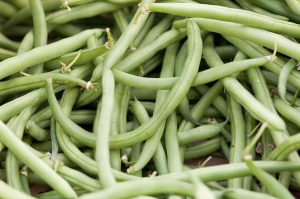Bulletin #4046, Let’s Preserve Snap Beans

Bulletin #4046, Let’s Preserve Snap Beans (PDF)
Developed by Penn State Cooperative Extension with special project funds from Extension Service, U.S. Department of Agriculture.
For information about UMaine Extension programs and resources, visit extension.umaine.edu.
Find more of our publications and books at extension.umaine.edu/publications/.
Recommended Varieties
Green: Blue Lake, Tendercrop, Tenderette (round podded), and Roma (flat podded) are excellent.
Wax: Midas, Gold Crop, Butterwax, and Bonanza Wax are good varieties.
Quantity
An average of 14 pounds is needed per canner load of 7 quarts; an average of 9 pounds is needed per canner load of 9 pints. A bushel weighs 30 pounds and yields 12 to 20 quarts. An average of ¾ pound makes 1 pint of frozen beans.
Quality
Select filled but tender, crisp pods. Remove and discard diseased and rusty pods.
Preparation
Wash beans, snip off and discard ends, and remove strings, if appropriate. Leave whole, or cut or snap into 1-inch pieces. Wash and drain prepared pieces.
Freezing Procedure
Don’t freeze more than 2 pounds of food per cubic foot of freezer capacity per day. Blanch 6 cups raw prepared beans at a time. Place each batch in 1 gallon of boiling water. Blanch small pieces 2 minutes and large pieces 3 minutes after the water returns to a boil. Cool quickly in several changes of cold water, and drain in a colander. Fill pint- or quart-sized freezer bags to a level of 3 to 4 inches from the top. Squeeze out air, leave 1-inch headspace, label, and freeze. Before freezing, bags may be inserted into reusable rigid plastic freezer containers for added protection against punctures and freezer burn.
Canning Procedure
Wash jars. Prepare lids according to manufacturer’s instructions. If desired, add 1 teaspoon of canning or pickling salt per quart. For raw packs, fill jars tightly with prepared beans, leaving 1-inch headspace. Add boiling water over beans, leaving 1-inch headspace. For hot packs, cover prepared beans in a large pot with boiling water, and boil 5 minutes. Fill jars with beans and the cooking liquid, leaving 1-inch headspace. Wipe the sealing surface of jars with a clean, damp paper towel. Add lids, tighten screw bands, and process in a pressure canner.
To process in a pressure canner, place jar rack, 2 inches of water, and sealed jars in canner. Fasten lid, and heat canner on high setting. After exhausting steam 10 minutes, add weighted gauge or close petcock to pressurize the canner. Start timing the recommended process when the desired pressure is reached.
Process Times
| Jar size | Process time (min.) | Dial gauge canner | Weighted gauge canner | ||||
|---|---|---|---|---|---|---|---|
| Canner gauge pressure at altitudes of | |||||||
| 0-2000 ft. (lbs.) | 2001-4000 ft. (lbs.) | 4001-6000 ft. (lbs.) | 6001-8000 ft. (lbs.) | 0-1000 ft. (lbs.) | Above 1000 ft. (lbs.) | ||
| Pints | 20 | 11 | 12 | 13 | 14 | 10 | 15 |
| Quarts | 25 | 11 | 12 | 13 | 14 | 10 | 15 |
Regulate heat to maintain a uniform pressure. When the processing is complete, remove canner from heat. Air-cool canner until it is fully depressurized. Then slowly remove weighted gauge or open petcock, wait 2 more minutes, and unfasten and carefully remove canner lid.
After processing is complete, remove jars from canner with a jar lifter and place on a towel or rack. Do not retighten screw bands. Air-cool jars 12 to 24 hours. Remove screw bands and check lid seals. If the center of the lid is indented, wash, dry, label, and store in a clean, cool, dark place. If the lid is unsealed, examine and replace jar if defective, use new lid, and reprocess as before. Wash bands and store separately. Beans are best if consumed within a year and safe as long as lids remain vacuum-sealed.
Nutritional Information
| Raw | Cooked | Canned | ||
|---|---|---|---|---|
| Boiled, drained | Solids, liquids | Drained solids | ||
| Calories | 17 | 22 | 66 | 13 |
| Carbohydrates, g | 3 | 4 | 4 | 3 |
| Fats, g | 0.06 | 0.1 | 0.1 | 0.07 |
| Protein, g | 1 | 1.1 | 1 | 0.7 |
| Sodium, mg | 3 | 2 | 3 | 3 |
| Vitamin A* | 6 | 8 | 6 | 4 |
| Vitamin C* | 10 | 10 | 6 | 4 |
*Expressed as percentage of the U.S. Recommended daily Allowances (US RDA). Other vitamins contained at insignificant levels.
Information in this publication is provided purely for educational purposes. No responsibility is assumed for any problems associated with the use of products or services mentioned. No endorsement of products or companies is intended, nor is criticism of unnamed products or companies implied.
© 2000
Call 800.287.0274 (in Maine), or 207.581.3188, for information on publications and program offerings from University of Maine Cooperative Extension, or visit extension.umaine.edu.
In complying with the letter and spirit of applicable laws and pursuing its own goals of diversity, the University of Maine System does not discriminate on the grounds of race, color, religion, sex, sexual orientation, transgender status, gender, gender identity or expression, ethnicity, national origin, citizenship status, familial status, ancestry, age, disability physical or mental, genetic information, or veterans or military status in employment, education, and all other programs and activities. The University provides reasonable accommodations to qualified individuals with disabilities upon request. The following person has been designated to handle inquiries regarding non-discrimination policies: Director of Equal Opportunity, 5713 Chadbourne Hall, Room 412, University of Maine, Orono, ME 04469-5713, 207.581.1226, TTY 711 (Maine Relay System).

